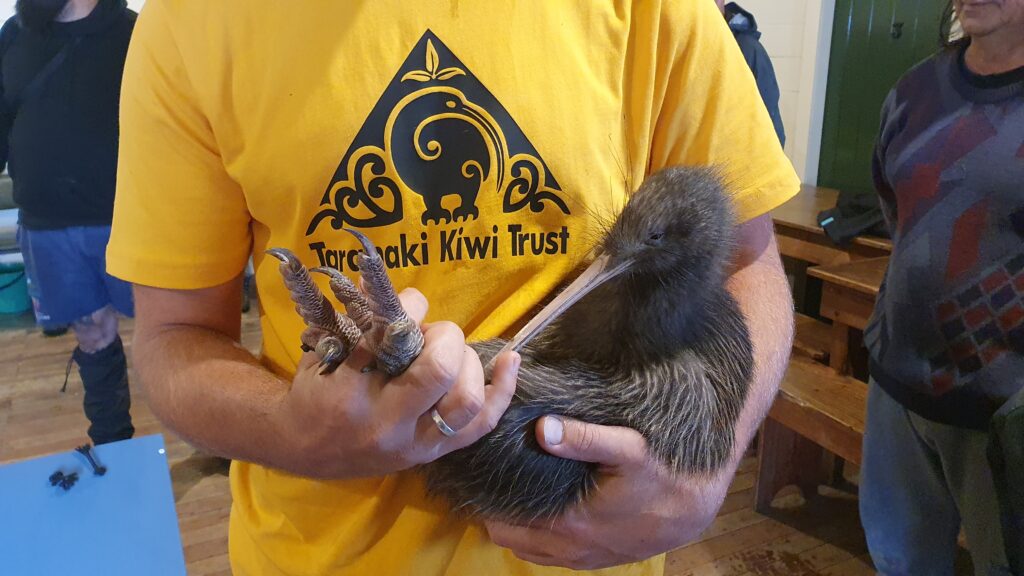It has been another largely successful year for monitoring programme, we are thrilled that kiwi are now resident across the northern side of the Maunga, Pouakai and Kaitake Ranges. Pictured is Toby with Deirdre who was named after one of our volunteers Rebecca Martin’s mother and released near the Camphouse this year, Deirdre is now partnered with Smutsy.
Birds released on Taranaki Maunga this year are well dispersed and are currently as far north as the Waiwhakaiho river, and South to Pembroke Road. Monitored kiwi consist of four that were part of the original group released in 2017, three released from TKKR in 2021, four in 2022, and a further nine released this year. Of those nine, two came from the Save the Kiwi creche at Wairakei the rest from the TKKR project. Not unusually two birds lost their transmitters, the process for attaching them ensures if they get snagged on anything they will break so that the bird is not trapped, four kiwi have died, and two transmitters appear to have failed. Waihaha who was named by the Dingle family when released unfortunately died in August 2022 due to suspected ferret predation. His body was found before the transmitter switched to mortality mode so he was sent to the pathology department at Massey University and the cause of death was confirmed as ‘likely mustelid predation’. Of the other two deaths, one was due to illness and the other two due to misadventure, falling off a bluff, sadly kiwi can be somewhat clumsy. During the past year three additional kiwi were released from the TKKR project without transmitters.
This year Dale, Silver, Torokaha and Ngaruru had successful nesting attempts on the Maunga. Dale and Silver both had two clutches, but we don’t know the outcome of Silver’s second nest as his transmitter failed while he was incubating. Koko and Popokotea both started incubating, but subsequently abandoned their nests. Health checks and transmitter changes give us an opportunity to check the bird’s overall condition as well as taking key measurements such as weight and bill length. It is pleasing that the manu are doing well on the Mounga as all were in moderate to very good condition.
There are now twenty-one kiwi being monitored in the Kaitake Range after three years of releases and the first time we released manu on the northern side of the range. All paired kiwi have remained in their territories and successfully bred, with most pairs having two clutches. Two of the second-year kiwi were set on a big OE and travelled well out of the Kaitake Range and up on to the Pouakai Range. The female Nikau dropped her transmitter and Toby finally caught up with Craig who is sponsored by Craigs Investment Partners with the help of intrepid volunteer Keith Coughtrey near Paul Falls and they removed his transmitter. In total two transmitters were dropped and two transmitters appear to have failed. Unfortunately, three kiwi Haimona, Bouush and Tamatea were found dead in August 2022, this and the deaths on the Maunga triggered a big response effort from all stakeholders to trap the culprits and up the ante on trapping, a ferret was caught on the Maunga and a cat in the Kaitake Ranges. All eleven birds released in 2023 have transmitters attached and will be monitored along with ten from the first and second years. All kiwi released in the Kaitake range so far have come from the TKKR project and will be monitored for at least a year after release for the first three years. All eight kiwi released in 2021 nested again and of the ten released in 2022, three pairs got together and nested.








31 Richmond Street
Inglewood, 4330
Postal Address:
PO Box 308
Stratford 4352
Phone: 027 454 0591
E-mail: admin@taranakikiwi.org.nz
Receive regular news and updates. Get involved in upcoming events and support the Taranaki Kiwi Trust.
Stay up to date, follow us on our social media channels;
The Taranaki Kiwi Trust is registered with the Charities Commission, Number CC22851. Therefore, donations and subscriptions made to the Trust over $5 are eligible for a tax rebate.